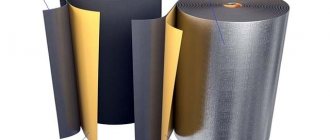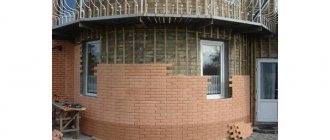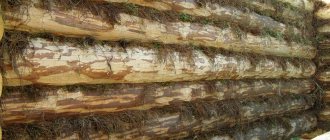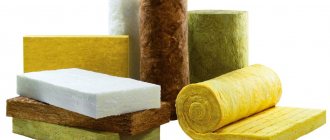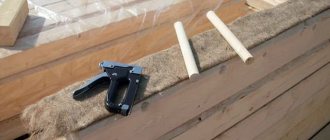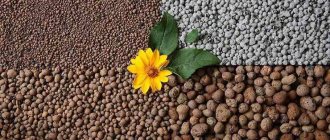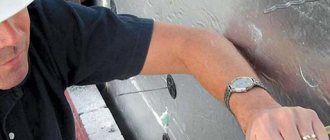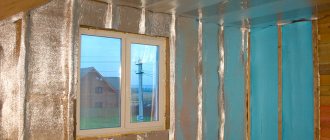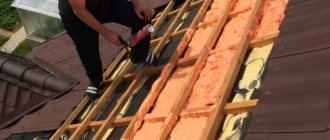How to pick something that won't be eaten
It is worth understanding that it is not so important for rodents to “eat” this insulation as to find a suitable place for their burrows. Therefore, they only gnaw small passages for themselves and walk there freely. It can be very difficult to get rid of mice that have settled between the walls; it is much easier to choose the insulation that they do not like.
Mice can eat chipboard Source stroimdom44.ru
But a rodent can mistake some floor and wall coverings for food. For example, particle board. The mouse will be able to make its own holes inside the slabs, and also eat it instead of its usual food. They are digestible because they are made from organic ingredients, so the body can digest them well. Materials from this line should be abandoned immediately, otherwise you can get neighbors and “lose” all the thermal insulation.
All the time, mice and rats sharpen their teeth, choosing wooden panels or foamed areas of the house.
Particular attention is paid to wires laid in walls or basements, which may be at risk of being chewed through. Therefore, it is worth asking what kind of insulation mice do not live in. Mice can become active even in asbestos panels, let alone simple foam for installing windows or doors.
Expanded clay
This material has long established itself not only as an excellent insulation material, but also as an absorber of noise from outside.
Filling floor cells with expanded clay Source keramzitspb.ru
If the task is to find which insulation does not harbor mice, then expanded clay is suitable. The material itself has a round shape of strong density. Fractions come in different sizes, from the smallest to quite large. Large rocks may theoretically allow rats to move around, but they will not build burrows. As for a shallow embankment, mice will fall into it like into sand, this will especially scare them away if the embankment is deep. And rats will drown because of their weight.
When pouring expanded clay, for example, to insulate the floor, there is quite a bit of free space left in the material itself, oxygen does not flow there and therefore mice will not be able to live there.
Fine expanded clay fraction Source hochu-stroitsya.ru
See also: Catalog of companies that specialize in home insulation
Small particles of such material enter the respiratory tract of rodents and clog the air flow there. In addition, expanded clay is not easy to chew, if at all possible. Mice will definitely not live in such material, since they understand that being there is dangerous.
Expanded clay is used to insulate floors, walls, basements, and attic floors. In addition to a good thermal insulation effect, you can also obtain insulation from extraneous noise.
Foam glass
Pests will not be able to breed inside this material. Presented in several forms at once, for example, crumbs, granules or blocks.
Foam glass block Source otdelkasten.com
Using blocks, you can quickly insulate indoor walls or the facade of a building. They also insulate the opening between the floor and the underground. Small crumbs are used as expanded clay fraction, poured onto the floor. It has the same properties and well protects the space of the house from the brood of mice.
Due to its strength, foam glass is resistant to pests, it is environmentally friendly and mold does not grow in it.
Ecowool
One of the new types of insulation, which has proven itself to protect against rodents. The material is made from paper waste, but it is environmentally friendly, has high thermal insulation, is fireproof, and well insulates the room from extraneous sounds. Ecowool is treated with an antiseptic.
Installation of ecowool on walls Source yandex.net
The insulation of the room is carried out using a special device; as soon as the material begins to initially set, it is rolled with a roller.
This is exactly the type of insulation that rodents do not live in. Due to its specific properties and processing, the insulation causes increased thirst in rodents and they lack air, so the mice are forced to run and leave this location.
Foam concrete
Another material that mice cannot live in due to its characteristics. Foam concrete can be compared to stone in strength, but it is quite lightweight and retains its properties for a long time.
Foam concrete insulation blocks Source kladka-penoblokov.ru
Inorganic insulation
Mice cannot chew through these materials. They are solid, and it is impossible to stay inside due to the small amount of oxygen.
Insulation is made from slag, glass, asbestos and rocks. It can be hard and free-flowing and can be produced in the form of slabs, mats, and rolls.
This group includes:
- Mineral wool. It can be stone or slag. Stone wool is made from rocks. The second type is made from slag, which is obtained during metal casting. Mice will not breed in mineral wool, but they can chew through it.
- Glass wool. It is made from the same materials as glass or from glass production waste. This includes the following types of insulation: basalt wool (fiberglass) and slag wool. Her most famous.
- Perlite and vermiculite. Loose and hard. This insulation is not eaten by mice because it is very hard on their teeth.
- Foam concrete and aerated concrete. Used when working with ceilings, walls and floors.
- Penoizol. Expensive insulation that can be used in a built house.
Rodents do not breed in inorganic insulation materials. But in mineral wool it is easy for them to make moves. House mice in glass wool are also capable of gnawing a hole into a food source.
Waterproofing films are often laid on top of the insulation. They help protect the structure from excess moisture and extend the life of the insulating material.
To protect and insulate pipes, fiberglass is usually used, which rodents do not favor.
Video description
What mice don’t eat
At the same time, it is immediately important to know what materials mice definitely won’t chew, and then move on to considering the least likely and favorable for rodents.
Mineral wool
Both glass and basalt mineral wool can not only be chewed by mice, but also transformed into their burrow. The most popular is glass wool. It is not only durable, elastic, and allows oxygen to pass through well, but mice often breed in it. They won’t eat it, since the glass wool is quite prickly, but mice will make passages in it.
A roll of glass wool as insulation Source orlovstroy.ru
Insulation that makes rodents comfortable
Cohabitation with rodents is unpleasant for humans. Pests cause damage to structures in the house, make holes in them and have offspring. Getting unwanted neighbors out is very difficult. It is important not only to know what kind of insulation mice and rats do not eat, but also to have information about the materials in which rodents willingly make their shelters.
If you still have rats, read the article: effective poisons for rats.
Multifunctional mineral wool
Mineral wool is produced by processing slag, impurities and rock melts. The seal meets all sanitary and hygienic criteria and standards. The following advantages of the material can be highlighted:
- excellent heat and sound insulation;
- long service life;
- fire resistance;
- resistance to fungus;
- strength;
- ease of installation.
Such insulation is also resistant to fire.
But with all its advantages, this material is liked not only by owners of private houses, but also by rodents. Mineral wool is quite soft, so mice and rats happily build their nests in it and give birth to offspring.
Polystyrene foam and polystyrene foam
Polystyrene foam is a very common means of thermal insulation due to its affordable price. The material has many advantages, including:
- harmlessness and environmental friendliness;
- unlimited service life;
- fire resistance;
- lightness and resistance to shrinkage.
But it has a significant disadvantage - mice and rats happily live in it. The material is not very durable, so it will not be difficult for pests to make passages in it. In addition, rodents love to eat this sealant.
If desired, the foam can be protected from pests. The mats can be covered with a metal mesh or poured with concrete on both sides, then the seal will be in reliable armor, but will still continue to perform its functions.
Extruded polystyrene foam is similar to polystyrene foam in composition, but these materials differ in their technical and physical properties. In addition, these seals are manufactured differently.
Polystyrene foam is obtained by processing the material with dry steam. Expanded polystyrene is created by melting a similar composition with the addition of fire retardants and other impurities. At the end, the raw material is enriched with carbon dioxide. The mass is foamed, and the frozen material is divided into slabs of the required dimensions. Extruded polystyrene foam has many advantages:
- light weight;
- no shrinkage;
- good soundproofing qualities;
- high level of thermal conductivity;
- environmental friendliness.
Read also: about the features of insulating a house with polystyrene foam.
But rodents very often live in this seal. The thicker the polystyrene foam, the more attractive it is to mice and rats. Pests feel comfortable in it, as the material is very warm.
How to insulate to keep mice away
Modern insulation materials, although they have increased thermal insulation, do not reliably protect a home from rodents entering it, like old slag, expanded clay and sawdust mixed with lime that has not been slaked. It is worth using materials that are difficult to chew through or are too small and dust can make it difficult for mice and rats to breathe inside the insulation.
Rodents in insulation Source naujienos.alfa.lt
At the same time, some people add mousetraps, poison or ultrasound to the insulation to repel rodents. Poison from rodents can negatively affect animals, children and the residents of the house themselves, so you should not add it to the insulation. Sound repellers, which work using ultrasound, act on mice and they run away. Some use wormwood for mice, and put it directly into the insulation. But you should understand that the branches may begin to rot and this will be no better than the appearance of rodents.
When it comes to the question of which insulation is best for a frame house against mice, it is better to give preference to those materials that mice do not chew, for example, expanded clay of any fraction.
What insulation materials can cause damage?
In addition to materials that are protected from penetration and consumption, there are also less safe ones. Mice settle in them and make passages in them, which can lead to drafts. These include:
- basalt wool;
- EPPS;
- self-expanding polyurethane foam;
- glass wool
Mineral wool
The coating is considered completely environmentally friendly and safe. The material is excellent for the colonization and reproduction of mice. Therefore, if there are complaints about the dominance of rodents in your place of residence, it is undesirable to use it. The best choice for using basalt wool would be the thermal insulation of urban high-rise buildings, where rodents are extremely rare.
Important! Basalt wool is not used by small animals for food, but they can populate it or make passages in its thickness.
Extruded polystyrene foam
Eps is a synthetic material that has been used since 1941. It is often used for thermal insulation of plinths and plaster facades. Can be used for roof installation.
Unfortunately, mice love it as much as architects. Despite zero nutritional value, they are able to colonize in it, which leads to the appearance of an abundance of passages.
Self-expanding polyurethane foam
The material is much more often used for waterproofing floors. Despite the quality of the coating and its ability to resist the penetration of moisture into the house, rodents live in such coating for a long time. Therefore, it is worth using self-expanding polyurethane foam very carefully in regions with a dominance of mice and rats.
Glass wool
It is a well-known fact that mice live in glass wool. In addition, they are able to consume the insulation as food. Today it is rarely used, but when choosing it as insulation, you need to be careful during installation. If there is a prevalence of rodents in the region or there are many fields or warehouses nearby, animals may enter the house.
Briefly about the main thing
In order to understand which insulation is not chewed by mice, it is important to consider its density, the presence of dust and the possibility of chewing by mice. For example, expanded clay will be quite difficult to chew through due to the fact that it has a structure like stone. But mice will quickly chew off the foam and make a lot of holes in it. Therefore, attention is paid specifically to the structure of the material. So ecowool and foam glass will protect the house from mice, because if pests start gnawing on such materials, they will get breathing problems. And they can easily turn any mineral wool into a home, although they won’t touch it.
Ratings 0
Thermal insulator and rodents
Never damage
At one time, figuring out which insulation is not chewed by mice, rats and voles, and which is “multiplied by zero” very quickly and with pleasure, I analyzed not only my own experience, but also specialized literature. As a result, all materials had to be divided into three groups, and here I will provide an overview of each of them.
Dense insulation, which is a porous substance in a hard shell, is almost never damaged by rodents. That is, the rat may gnaw through a hole in them (and what will it not gnaw through?), but it will be as short as possible, and therefore, if detected, we can easily seal it.
Thermal insulation made of foam glass will remain intact!
In this category I will include the following options:
- Foam glass is an ideal thermal insulation material from the point of view of protection against rodents, consisting of lightweight panels made of foamed silicate raw materials. The high strength of the foam glass cladding provides good protection from damage, and the small particles with sharp edges that form when chipped off injure the oral cavity of rodents, so they quickly give up trying to “test the foam glass.”
- Foam concrete is somewhat inferior to foam glass in terms of “mouse repellent” characteristics, but at the same time it has good thermal insulation ability. Dense foam concrete cladding is almost never damaged by mice or rats, especially if it is mounted on top of a wall made of durable materials (concrete, solid brick).
Mice do not chew expanded clay itself, but they can dig in it
- Expanded clay is granules of baked clay that are used for bulk thermal insulation. The advantages of this material are significant availability, reasonable price and ease of use. Neither rats nor mice chew expanded clay, but if necessary they can make passages through the expanded clay backfill. To prevent such a development of events, I either immediately pour expanded clay concrete into the cavities, or simply fix expanded clay granules with a liquid solution, which sets and turns the thermal insulation layer into a monolith.
- In the list of insulation materials that rodents ignore, I will include not only dense materials. There are also organic raw materials, which, in theory, should be very appetizing - ecowool. Despite the fact that the basis of the insulation is cellulose, orthoboric acid, which is part of the impregnation, effectively repels both mice and rats, causing them suffocation and systematic dehydration .
Paradox: mice don’t touch this loose substance
These four points need to be known to any owner for whom the priority is the protection of thermal insulation circuits from damage by rodents. If the problem with mice is episodic, i.e. They exist, but they don’t bother me too much yet – you can consider other materials.
Sometimes they do damage
In this category I included insulation materials, which, on the one hand, are of no “gastronomic” interest for mice and rats, but on the other hand, can be damaged and used to make nests. This list included:
- Mineral wool (both loose rolled materials and dense basalt insulation). Very often it is positioned as a material in which rodents do not live, but this is not entirely true: yes, the fibers themselves are rarely damaged by rats or mice, but at the same time the raw material can be easily chewed through and used to make nests. In addition, pests usually enter the room by literally seeping through at the junction of the panel of thermal insulation material to the sheathing or load-bearing surface: we lay the mineral wool so that it does not compact or deform, so rodents take advantage of it.
Mouse movement inside mineral wool: if there is an incentive, they will chew
- Extruded polystyrene foam. It is also a fairly dense raw material that rarely suffers from gnawing. Unfortunately, “rarely” does not mean “never”: a layer of polystyrene insulation will not become an insurmountable barrier for a rat, and if it decides to get inside, it will do so without serious difficulties, and even more so without consequences for its health.
- Self-expanding polyurethane foam. The material itself is quite dense and rats and mice gnaw it quite rarely. But over time, without proper protection, polyurethane gradually deteriorates under the influence of moisture and ultraviolet radiation... with a known result!
If you don't protect the foam, it will begin to collapse on its own, and rodents will speed up the process.
The instructions strongly recommend isolating polyurethane thermal insulation layers from the external environment, at least by painting.
- Finally, last on this list is glass wool. All its disadvantages, which anyone who has tried to work with fiberglass with their own hands knows, will become advantages here: a layer of 5 cm of this material is enough, and rodents will not go any further, fearing for their health without reason.
Be no stupider than mice - work with glass wool only with gloves, goggles and a respirator!
Chew easily and regularly
Above we looked at what kind of insulation mice do not eat, now it’s worth figuring out what materials can (and will definitely be) damaged:
Photo of a foam block with a nest inside
- Polystyrene foam is the cheapest, most popular, and therefore probably the most sought-after insulation material. It gnaws through “in an instant”, spreads throughout the house, inside rats, mice and voles create entire labyrinths with nests, passages and warehouses. It is almost impossible to protect .
- Penoizol is a sprayed foam that, when hardened, forms a relatively uniform structure. It is a little worse to chew on, but with a large scale of rodent invasion, you “hardly” will not notice it.
There was polystyrene foam - and there is no polystyrene foam
- Expanded polystyrene is somewhat denser than polystyrene foam, but this usually doesn’t bother mice much . If you used polystyrene foam for insulation, and you have a lot of mice, then you will soon see all the delights like gnawed holes, passages, nests with broods of young animals and white crumbs throughout the house.
How to prevent damage to insulation
As you can see, the list of “edible” materials covers all popular and frequently used insulation materials. However, even taking into account the great interest in them from rodents, they are used and very successfully. The answer lies in thoughtful insulation design and implementation.
The best option is a combination of materials. If you lay “inedible” material around the perimeter of the insulated space, and mineral wool or polystyrene inside, then protection against rodents will already be built, and the insulation of the house will not be affected.
If there is no way for rats to get into the mineral wool slabs, they will not settle there. As a barrier, reinforcement with barbed wire and fine-mesh mesh is used on all approaches from the foundation and roof, when it comes to walls. You can use broken glass and lay it underneath and on top of the insulation layer.
Special antiseptic compounds are often used, including borax, which can reduce the activity of rodents and repel them from the material. The main thing is to do all this at the installation stage, since otherwise you will have to deal with the consequences.
For especially dangerous and risky places, where you can’t get rid of the close attention of rodents, you should pay attention specifically to the insulation material, giving preference to its “inedibility”. https://www.youtube.com/embed/9WGCZ0c7Vck

